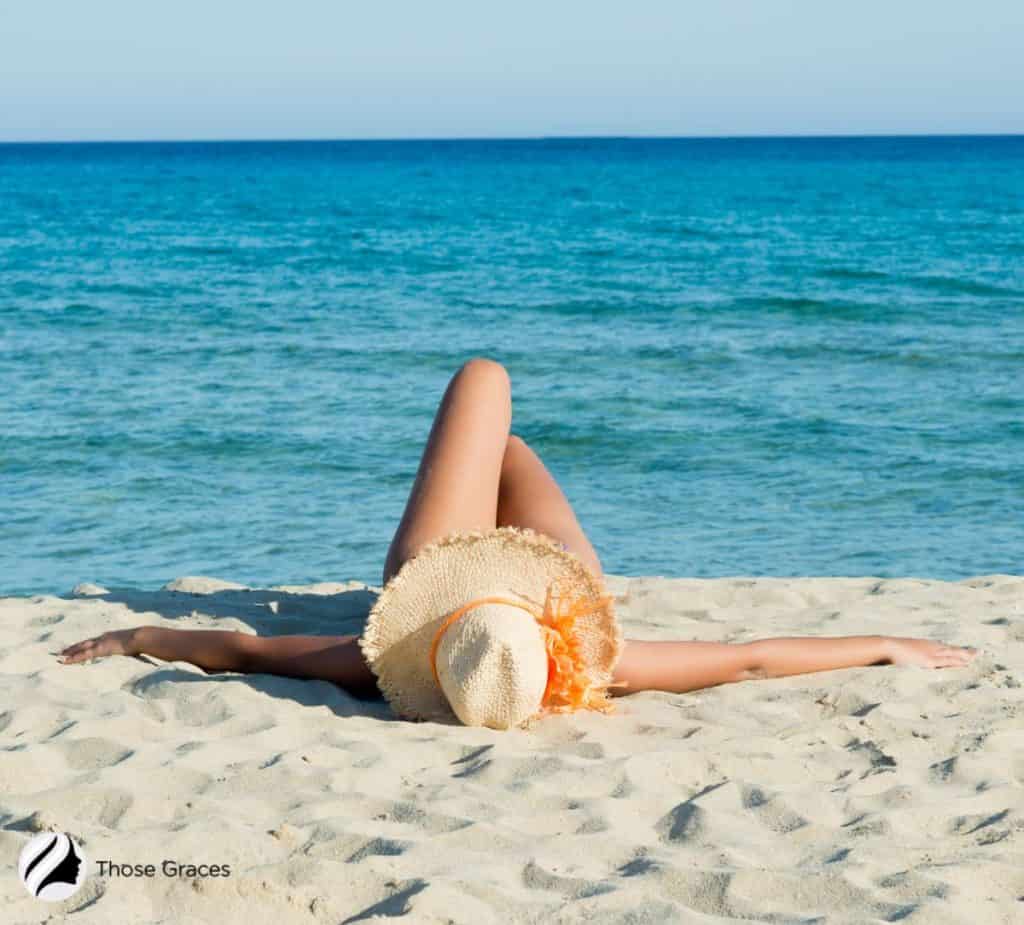How long in the sun to get vitamin D?
Experts say around 5-30 minutes under the sun is ideal. Then again, you’ll have to adjust this range according to your skin color and circumstances.
Keep reading to learn the many benefits of vitamin D and how you can make the most of lying under the sun!
Table of Contents
Key Takeaways:
- Vitamin D benefits our overall health, and sun exposure is the best source of vitamin D. All skin types make an active form of vitamin D in the body when exposed to the sun.
- Light-skinned people need only about 10-30 minutes of sun exposure per day. In comparison, dark-skinned should spend at least 30 minutes under the sun for optimal levels of vitamin D.
- Noon or around 10 a.m. to 3:00 p.m. is the best time to get vitamin D, but there are risks with unprotected sun exposure.
How Long to Sit in Sun for Vitamin D?
How long in the sun to get vitamin D, you ask? It depends on your skin color.
In general, scientists say 5-30 minutes of sun exposure is needed daily to get enough Vitamin D.
Light-skinned people need only about 5-30 minutes [1] of sun exposure per day for sufficient vitamin D.
Individuals with darker skin, however, require anywhere from 30 minutes [2] to 3 hours of direct sunlight for optimal vitamin D levels.
This is because more significant amounts of melanin in their skin reduce the skin’s ability to produce enough vitamin D from sunlight. So, people with darker skin are more at risk for vitamin D deficiency.
You may want to watch this video if you suspect you are at risk of vitamin D deficiency:
Benefits of Vitamin D
Vitamin D, also known as the sunshine vitamin, provides many health benefits. This includes lowering the risk of skin cancer and cardiovascular disease.
In a Framingham Heart Study [3], patients with low vitamin D concentrations had a 60% higher risk of heart disease than those with higher concentrations.
Not only that, but Vitamin D also supports mental and skeletal health, alongside preventing many medical health risks.
Below are more significant health benefits of Vitamin D:
- Supports weight loss
- It helps your immune system function properly
- Promotes calcium absorption and bone health
- It helps with mood swings and reduces the risk of depression
- Reduces risk of autoimmune diseases
On the other hand, vitamin D deficiency or a low vitamin D status is a very common condition worldwide [4] and is linked to several chronic diseases.
How Do You Get Vitamin D From the Sun?
Vitamin D exists in two forms. There’s Vitamin D2 which comes from plants, particularly in yeast and mushroom exposed to UV light.
On the other hand, vitamin D Receptors (VDR) are present in most tissues and cells in the body. This allows humans to synthesize vitamin D3 [5] when UVB light from the sun strikes the skin.

So, vitamin D3 is the most “natural” form of Vitamin D. It’s safe to say that people who like to get tanned kill two birds with one stone. They’re getting that golden glow while maintaining a good level of Vitamin D.
Click here to learn how long does a tan take to develop.
What Is the Best Source of Vitamin D?
Even though the market is rife with vitamin D supplements, the best source of vitamin D is still the sun.
In fact, the natural production of Vitamin D [7]may last at least twice as long in the blood compared with Vitamin D Supplementation.
Although supplements, egg yolk, cod liver oil, and salmon are good sources of vitamin D, regular exposure to the sun is the more long-term and inexpensive solution.
Vitamin D toxicity is also a risk from taking too many Vitamin D supplements, but it is rare.
If you have a vitamin D deficiency, you may have to see your healthcare provider for dietary supplements, especially during the winter months.
How Much Vitamin D Do You Get From the Sun?
The recommended daily dose of vitamin D is 600–800 [8] International Units (IU) for adults.
According to a study [9] published in the National Library of Medicine, 30 minutes of the midday summer sun was equivalent to 10,000–20,000 IU of vitamin D intake.
Amazing, right? So, the more time you spend under the sun, the more you surpass that minimum requirement.
But it’s not just the amount of time spent in the sun that matters; it’s also the intensity of the rays. Notice that it said “midday summer sun”?
This gives us a clue about the best time to lay under the sun, which I will discuss below!
Best Time to Sit in Sun for Vitamin D
Can you sit in the sun any time of the day? What is the best time to sit in the sun for vitamin D? Here are the answers.
Most experts say the best time to sit under the sun is around noon, particularly between 11:00 a.m. to 3:00 p.m. You also want to expose as much skin as possible to increase vitamin D levels throughout your body.

The sunlight is quite intense during these times, but this also means you don’t have to sit too long under the sun. You’ll produce vitamin D in bulk at noon, especially during the summer months!
Nonetheless, you can take advantage of the early morning hours before sunrise. Light during this time of day is much weaker than the midday sun, so this will require you to stay a little longer.
You may also read this post about the best time to sunbathe.
Risks of Too Much Sunlight
All of this said, there are risks associated with prolonged unprotected sun exposure. These include sunburns, eye damage, skin cancer, and premature aging. This is where sunscreen comes in.
Sunscreens are essential because they protect our skin from harmful UV rays. However, sunscreens can get in the way of Vitamin D production as it blocks out UVA rays.
With this in mind, it’s best to spend more time than usual under the sun when wearing sunscreen. This will ensure you’re getting enough vitamin D without risking skin damage.
FAQs
Can you have too much vitamin D?
What are other good sources of Vitamin D?
How do I know if I have vitamin D deficiency?
Does vitamin D prevent cancer?
Is morning sun good for vitamin D?
Conclusion
Vitamin D is a versatile nutrient supporting mental and physical health. The best source of vitamin D is sun exposure.
How long does to stay in the sun to get vitamin D? Light-skinned people need only about 10-30 minutes of sun exposure per day, while dark-skinned people should spend at least 30 minutes under the sun for optimal vitamin D levels.
Noon or around 10 a.m. to 3:00 p.m. is the best time to get the most IU of vitamin D.
There are risks with staying too long under the sun, so use sunscreen and this article to make an informed decision about sun exposure.

So, how long do you in the sun to get vitamin d? Let us know in the comments section!
References:
- Lesley Rhodes, Ann Webb, Heather Fraser, Richard Kift, Marie Durkin, Donald Allan, Sarah O’Brien, Andy Vail, Jacqueline Berry. Recommended summer sunlight exposure levels can produce sufficient (> or =20 ng ml(-1)) but not the proposed optimal (> or =32 ng ml(-1)) 25(OH)D levels at UK latitudes.[Journal Article]. J Invest Dermatol. Available from: https://pubmed.ncbi.nlm.nih.gov/20072137/
- WebMD Staff. Sunlight and Your Health [Internet]. www.webmd.com. Available from: https://www.webmd.com/a-to-z-guides/ss/slideshow-sunlight-health-effects
- Thomas J. Wang, Michael J. Pencina, Sarah L. Booth, Paul F. Jacques, Erik Ingelsson, Katherine Lanier, Emelia J. Benjamin, Ralph B. D’Agostino, Myles Wolf, and Ramachandran S. Vasan. Vitamin D Deficiency and Risk of Cardiovascular Disease [Journal Article]. AHA Journals. Available from: https://www.ahajournals.org/doi/full/10.1161/CIRCULATIONAHA.107.706127
- Karin Amrein, Mario Scherkl, Magdalena Hoffmann, Stefan Neuwersch-Sommeregger, Markus Köstenberger, Adelina Tmava Berisha, Gennaro Martucci, Stefan Pilz & Oliver Malle. Vitamin D deficiency 2.0: an update on the current status worldwide [Journal Article]. Eur J Clin Nutr 74. Available from: https://www.nature.com/articles/s41430-020-0558-y
- Nair R, Maseeh A. Vitamin D: The “sunshine” vitamin [Journal Article]. J Pharmacol Pharmacother. Available from: https://www.ncbi.nlm.nih.gov/pmc/articles/PMC3356951/
- J G Haddad, L Y Matsuoka, B W Hollis, Y Z Hu, and J Wortsman. Human plasma transport of vitamin D after its endogenous synthesis [Journal Article]. J Clin Invest. Available from: https://www.jci.org/articles/view/116492
- Mayo Clinic Staff. Vitamin D [Internet]. www.mayoclinic.org.Available from: https://www.mayoclinic.org/drugs-supplements-vitamin-d/art-20363792
- Michael F Holick, Tai C Chen, Zhiren Lu, Edward Sauter. Vitamin D and skin physiology: a D-lightful story [Journal Article]. J Bone Miner Res.Available from: https://pubmed.ncbi.nlm.nih.gov/18290718/
- Theresa Shao,Paula Klein and Michael L. Grossbarda. Vitamin D and Breast Cancer [Journal Article]. Oncologist. Available from: https://www.ncbi.nlm.nih.gov/pmc/articles/PMC3267821/



